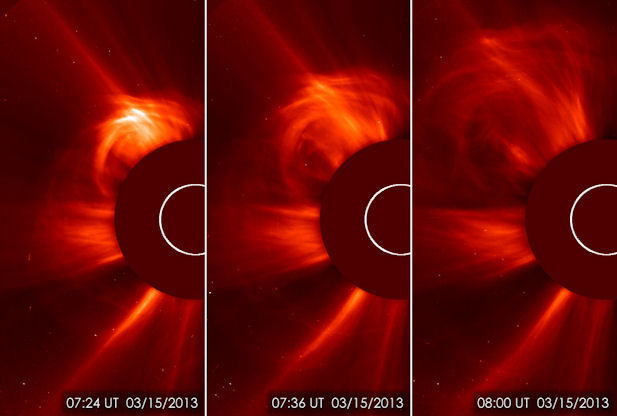In early March 2012, two solar flares erupted, sending a streaming cloud of charged particles (known as a coronial mass ejection or CME) hurtling towards Earth.
NASA and other Sun watchers were concerned because CMEs like these can cause severe geomagnetic storms. These storms can produce harmless and beautiful auroras (coloured bands of light in the night sky) at low latitudes and, of concern to us Earthlings, impact on the ozone layer, disrupt high-frequency radio communication, global positioning systems (GPS) and power grids.
Largest solar flares in the current solar cycle
NASA reports that the flare on 6 March 2012 is the second largest so far in the current 11-year solar cycle. This flare was categorised as an X5.4, making it the second largest flare after an X6.9 on 9 August 2011. Solar flares are categorised by their size – according to the peak flux recorded in watts per square metre (W/m2) as an A, B, C, M or X-class flare. A B-class solar flare releases 10 times more energy than an A-class flare, while a C-class eruption releases 10 times more than a B-class flare (and 100 times more than class A). Within each letter class, there is also a scale from 1–9.
The current solar cycle is expected to peak in the next 12 months, so we can expect more and possibly larger flares in the year ahead. However, not all solar storms are ejected towards the Earth.
Dr Alina Donea, an astrophysicist in the Monash Centre for Astrophysics in Australia, says the X5.4 solar flare was similar in size to one called the Bastille Day flare, which occurred on 14 February 2000.
“That flare was one of the largest geomagnetic storms of the previous solar cycle, accompanied by a massive coronal mass ejection, which was initially travelling at a speed of approximately 1,800 km/s.
Effects on Earth’s magnetosphere
“It was big enough to cause the Earth’s magnetosphere to become extremely compressed and eroded on the day-side, causing three geosynchronous satellites to enter the magnetosheath for an extended time period [up to 3 hours]. The Extreme ultraviolet Imaging Telescope (EIT) on NASA’s SOHO satellite found itself so bombarded by high flux from the Sun that it became saturated and couldn’t record any useful readings.
“The Sun also sent solar energetic particles [SEPs] towards Earth. Through a series of chemical reactions in our atmosphere, these SEP protons drastically diminished the uppermost areas of the ozone layer – a protective blanket mostly in the stratosphere that blocks life-threatening ultraviolet radiation from reaching the Earth. This did not, however, result in a significant impact on human health, especially considering that most of the ozone loss documented in this study occurs over the northern polar region, [but] they are important scientifically. So, a general comment is that we should expect more or less a similar impact to the Earth.”
Possibility of a seismic event in the Sun
“A very important question for us in relation to these flares of March 2012 is has this March 2012 X5 flare produced a solar quake in the Sun? The Bastille Day flare did not generate a seismic event, but this one might have ignited a very big one. We will find the answer soon – the Monash University team works on this. If the flare generated a sunquake, then our puzzle about why some flares produce quakes and others do not is even bigger.”
Dr Donea also notes that our dependence on high-tech communications systems has made us more vulnerable to such events, whereas in the past, such geomagnetic storms would have gone unnoticed by most people.
“But we should not panic. Previous flares have taught researchers lessons. We learned more about how to operate the instruments during extreme solar activity.”
Related content
Find out more about Space weather.
The Monash Centre for Astrophysics in Australia investigates the effects of solar flares, including Earth’s ozone loss. Your students may like to watch this video clip, Ozonesonde launch, which explains how New Zealand scientists monitor ozone distribution.


